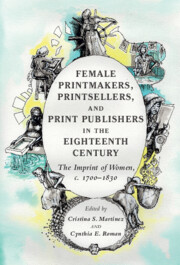 Female Printmakers, Printsellers, and Print Publishers in the Eighteenth Century
Female Printmakers, Printsellers, and Print Publishers in the Eighteenth Century Book contents
- Female Printmakers, Printsellers, and Print Publishers in the Eighteenth Century
- Female Printmakers, Printsellers, and Print Publishers in the Eighteenth Century
- Copyright page
- Dedication
- Contents
- Figures
- Contributors
- Acknowledgements
- Frontispiece
- Introduction: Hidden Legacies
- Part I Self-Presentation and Self-Promotion
- Chapter 1 Show-Offs
- Chapter 2 Maria Hadfield Cosway’s ‘Genius’ for Print
- Chapter 3 Caroline Watson and the Theatre of Printmaking
- Chapter 4 ‘Talent and Untiring Diligence’
- Part II Spaces of Production
- Part III Competing in the Market: Acumen in Business and Law
- Index
Chapter 3 - Caroline Watson and the Theatre of Printmaking
from Part I - Self-Presentation and Self-Promotion
Published online by Cambridge University Press: 14 March 2024
- Female Printmakers, Printsellers, and Print Publishers in the Eighteenth Century
- Female Printmakers, Printsellers, and Print Publishers in the Eighteenth Century
- Copyright page
- Dedication
- Contents
- Figures
- Contributors
- Acknowledgements
- Frontispiece
- Introduction: Hidden Legacies
- Part I Self-Presentation and Self-Promotion
- Chapter 1 Show-Offs
- Chapter 2 Maria Hadfield Cosway’s ‘Genius’ for Print
- Chapter 3 Caroline Watson and the Theatre of Printmaking
- Chapter 4 ‘Talent and Untiring Diligence’
- Part II Spaces of Production
- Part III Competing in the Market: Acumen in Business and Law
- Index
Summary
This chapter investigates Caroline Watson’s understudied theatrical subjects which testify to her technical mastery and ambitious agenda as a printmaker and provide a lens for examining how gender, printmaking hierarchies, and patronage impacted her exceptional career as a female stipple engraver. Her prints of female Shakespearean characters, Garrick Speaking the Ode and Sarah Siddons as Euphrasia, after Robert Edge Pine, from the early 1780s, and her two large plates for Boydell’s Shakespeare Gallery in the 1790s affiliated her with Shakespeare and the most significant artistic enterprise of the late eighteenth century. In terms of scale, narrative complexity, and narrative scope, Watson’s theatrical prints demonstrate her extraordinary skill as a stipple engraver and challenge gender and printmaking hierarchies. Appointed Engraver to the Queen in 1785, Watson signed her prints, publishing a number under her own name, and supported herself comfortably through her printmaking. Despite her professional achievement and technical prowess, her extended independent career was circumscribed by hierarchies of gender that paralleled artistic hierarchies.
- Type
- Chapter
- Information
- Female Printmakers, Printsellers, and Print Publishers in the Eighteenth CenturyThe Imprint of Women, c. 1700–1830, pp. 40 - 55Publisher: Cambridge University PressPrint publication year: 2024
